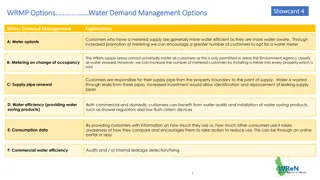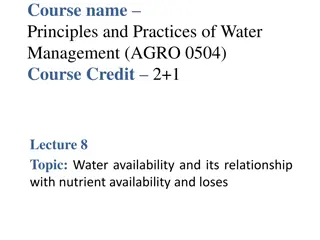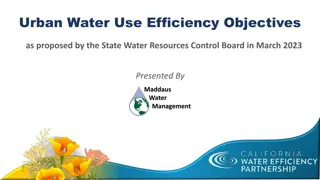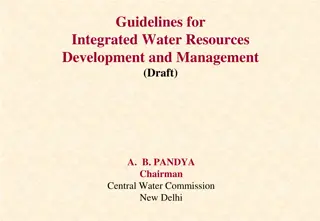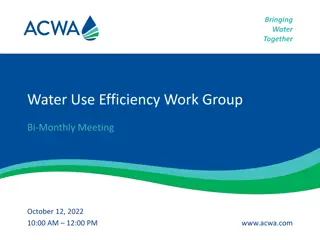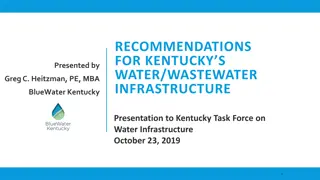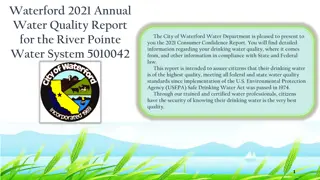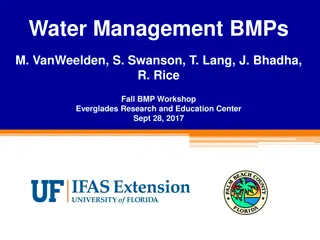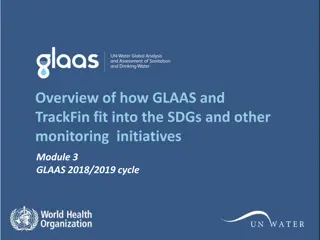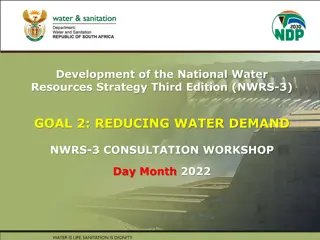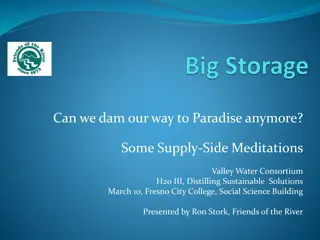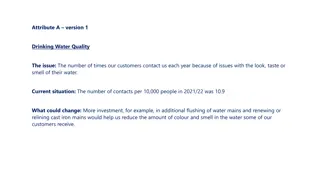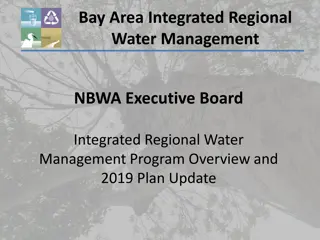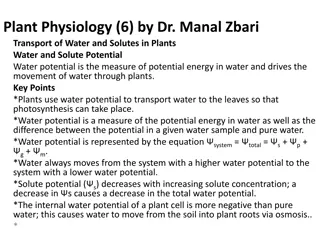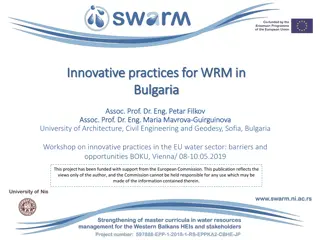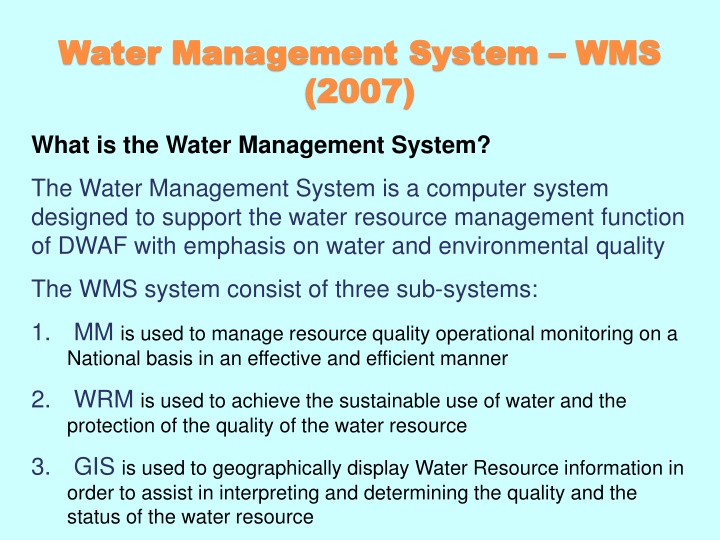
Water Management System Overview
The Water Management System (WMS) is a computer system supporting water resource management, emphasizing environmental quality. It consists of sub-systems like MM for resource quality monitoring, WRM for sustainable water use, and GIS for geographic water resource information display. WMS aids in maintaining databases, operational monitoring, discharge impacts, compliance, trend determination, incident management, and more. It defines geographical features relevant for water resource management like rivers, dams, estuaries, and groundwater, analyzing their impact and association with water-use sites and industries.
Uploaded on | 1 Views
Download Presentation

Please find below an Image/Link to download the presentation.
The content on the website is provided AS IS for your information and personal use only. It may not be sold, licensed, or shared on other websites without obtaining consent from the author. If you encounter any issues during the download, it is possible that the publisher has removed the file from their server.
You are allowed to download the files provided on this website for personal or commercial use, subject to the condition that they are used lawfully. All files are the property of their respective owners.
The content on the website is provided AS IS for your information and personal use only. It may not be sold, licensed, or shared on other websites without obtaining consent from the author.
E N D
Presentation Transcript
Water Management Water Management System System WMS (2007) (2007) WMS What is the Water Management System? The Water Management System is a computer system designed to support the water resource management function of DWAF with emphasis on water and environmental quality The WMS system consist of three sub-systems: 1. MM is used to manage resource quality operational monitoring on a National basis in an effective and efficient manner 2. WRM is used to achieve the sustainable use of water and the protection of the quality of the water resource 3. GIS is used to geographically display Water Resource information in order to assist in interpreting and determining the quality and the status of the water resource
Supported Business Functions 1 Supported Business Functions 1 WMS is an inter-directorate initiative and support, or will support the following business functions directly or indirectly: Maintain a national water and environmental quality database Manage national and regional operational monitoring Effluent discharge impacts Compliance to license conditions
Supported Business Functions 2 Supported Business Functions 2 WMS is an inter directorate initiative and support, or will support the following business functions directly or indirectly: Compliance to goals and objectives Trend determination Status of water resources Fitness of water for human health Incident management Catchments management
Supported Business Functions 3 Supported Business Functions 3 WMS is an inter directorate initiative and supports, or will support, the following business functions directly or indirectly: Toxicity assessments Reserve determination Future possibilities: What if scenarios Modelling
How? How? - - Water Network Water Network Define the Geographical Features relevant for water resource management Resources: Rivers Water Bodies Dams/Reservoirs Estuaries Wetlands Groundwater Features What impact on resources? Water-use Sites Industries Mines Other Sites How do they affect each other? Water flow association Rivers - Rivers Source Resource Discharge Extraction Monitoring points/sectors Status Impact Auditing Geographical Areas: Management Areas - WMA Provinces Drainage Regions Local Authorities Land-use, etc
How? How? - - Water Management Water Management Define the stakeholders relevant for water resource management Monitoring resources Laboratories Monitoring Program owners Water-use site ownership Water management structures Clusters CMAs Public participation structures Forums Contact Details: Addresses Postal Electronic Telephonic Contact Persons Water management structures: Monitoring structures Laboratory structures Waste & waste discharge Management
How? How? - - Monitoring Variables Monitoring Variables Define the constituents- determinants relevant for water resource management The variables are determined through: Laboratory analysis Field measurements On-site observations Derived from measured values. Water quality & quantity determinant types: Chemical, Physical Organic Biological Microbiology Flow Radioactivity. Biota Habitat Morphology Vegetation Morphology Chemical Physical Organic Biological
How? How? - - Operational Monitoring Operational Monitoring Define monitoring programs Update resource base: Monitors & laboratories Variables & methods Monitoring Actions & frequencies Equipment to use Transport and packaging methods State monitoring program requirements: Monitoring Point Monitoring Action Frequency of monitoring Analysis or Field measurement requirements State monitoring program resources to be used: Monitoring office Laboratory Analysis method Containers Preservatives Schedule monitoring: Consolidate all requirements Schedule sampling & analysis Provides equipment support Audit monitoring compliance
How? How? - - Data Capture Processes Data Capture Processes Program related sampling Sampling Registration Not program related sampling Sampling Quality Assurance Make available for Assessment and Reporting Electronic supplied results Analysis Registration Laboratory result transfers Analysis Quality Assurance
How? Compliance Management How? Compliance Management Identify Geographical Features Set waste standards Set resource objectives Run compliance Report compliance Implement corrective measures
How? How? - - Compliance Management Compliance Management Identify geographical feature monitoring points Run compliance Report compliance Set waste standards Graphical Display Set resource objectives
How? How? - - Reporting Reporting Standard raw data Standard External System Export Graphs Descriptive statistics CSV (spreadsheet) format Analysis Status DBF GIS Format Word format Others
How? How? Multimedia Multimedia Library Library Documents Multi Media Library Water Network Photographs Sound clips Video clips Correspondence Management Stakeholders References
WMS System Functions WMS System Functions - - MM MM Monitoring Management Subsystem Auditing of the Monitoring Process Data Capture and Quality Assurance Monitoring Programs and Scheduling Analysis Requirements Monitoring Requirements Water Network
WMS System Functions WMS System Functions - - WRM Water Resource Management Sub- system WRM Reporting & Data Supply Compliance Objectives & Standards Stakeholders & Management Structures Flow Association & Impact Water Network
WMS System Functions WMS System Functions Reporting & Data Supply Data Capture and Quality Assurance Compliance Monitoring Programs and Scheduling Stakeholders & Management Structures Water Network
WMS Infrastructure Distribution WMS Infrastructure Distribution Terminal Emulation Connection Terminal Emulation Connection KwaZulu Natal Mpumalanga Erwat Laboratories Limpopo North West Buffalo City Northern Cape External Users Western Cape RQS HQ Gauteng Freestate
WMS Infrastructure WMS Infrastructure - - Local Server Local Server Client Server Configuration Office with Local Server User PC Local Area Network with Front end Software Remote Database Server Remote Database Server Database Server
WMS Infrastructure WMS Infrastructure Remote Server Server Remote Client Server Configuration Office with Terminal Emulation User PC with Terminal Emulation Terminal Server Local Area Network Remote Database Server Remote Database Server Database Server
WMS Infrastructure WMS Infrastructure External Server Server External Client Server Configuration External office with Terminal Emulation User PC with Terminal Emulation Terminal Server OPENNET Local Area Network Remote Database Server Remote Database Server Database Server



